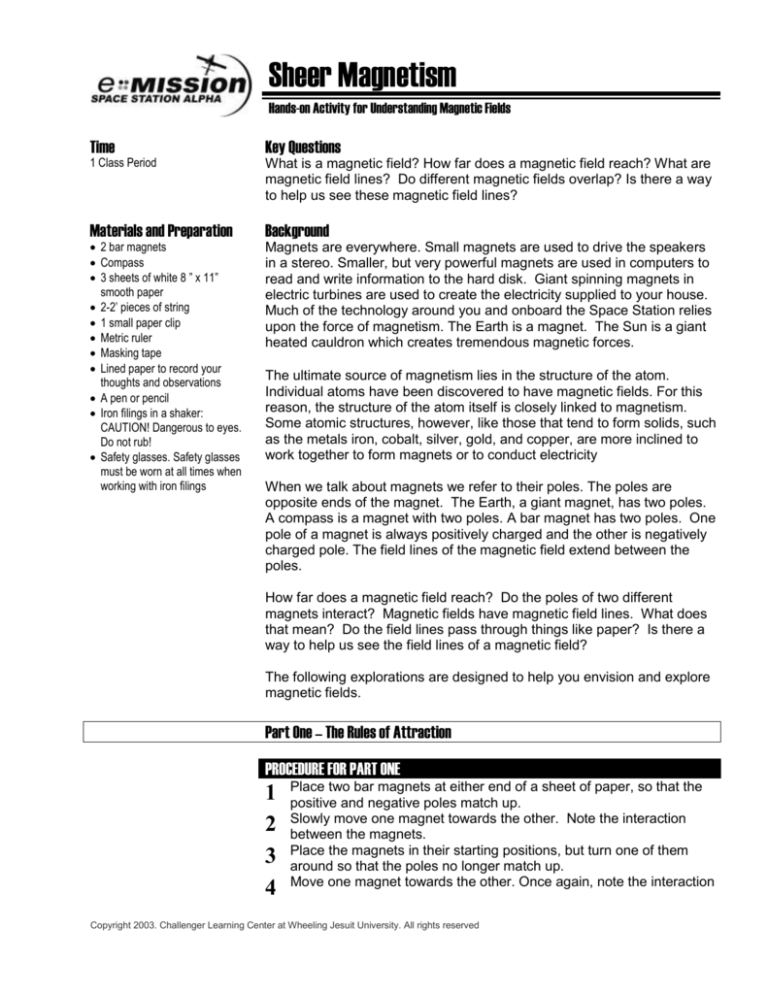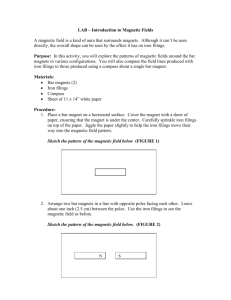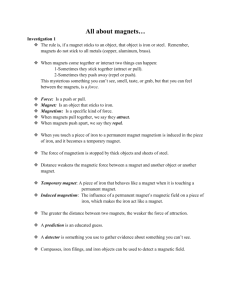
Sheer Magnetism
Hands-on Activity for Understanding Magnetic Fields
Time
1 Class Period
Materials and Preparation
2 bar magnets
Compass
3 sheets of white 8 ” x 11”
smooth paper
2-2’ pieces of string
1 small paper clip
Metric ruler
Masking tape
Lined paper to record your
thoughts and observations
A pen or pencil
Iron filings in a shaker:
CAUTION! Dangerous to eyes.
Do not rub!
Safety glasses. Safety glasses
must be worn at all times when
working with iron filings
Key Questions
What is a magnetic field? How far does a magnetic field reach? What are
magnetic field lines? Do different magnetic fields overlap? Is there a way
to help us see these magnetic field lines?
Background
Magnets are everywhere. Small magnets are used to drive the speakers
in a stereo. Smaller, but very powerful magnets are used in computers to
read and write information to the hard disk. Giant spinning magnets in
electric turbines are used to create the electricity supplied to your house.
Much of the technology around you and onboard the Space Station relies
upon the force of magnetism. The Earth is a magnet. The Sun is a giant
heated cauldron which creates tremendous magnetic forces.
The ultimate source of magnetism lies in the structure of the atom.
Individual atoms have been discovered to have magnetic fields. For this
reason, the structure of the atom itself is closely linked to magnetism.
Some atomic structures, however, like those that tend to form solids, such
as the metals iron, cobalt, silver, gold, and copper, are more inclined to
work together to form magnets or to conduct electricity
When we talk about magnets we refer to their poles. The poles are
opposite ends of the magnet. The Earth, a giant magnet, has two poles.
A compass is a magnet with two poles. A bar magnet has two poles. One
pole of a magnet is always positively charged and the other is negatively
charged pole. The field lines of the magnetic field extend between the
poles.
How far does a magnetic field reach? Do the poles of two different
magnets interact? Magnetic fields have magnetic field lines. What does
that mean? Do the field lines pass through things like paper? Is there a
way to help us see the field lines of a magnetic field?
The following explorations are designed to help you envision and explore
magnetic fields.
Part One – The Rules of Attraction
PROCEDURE FOR PART ONE
1
2
3
4
Place two bar magnets at either end of a sheet of paper, so that the
positive and negative poles match up.
Slowly move one magnet towards the other. Note the interaction
between the magnets.
Place the magnets in their starting positions, but turn one of them
around so that the poles no longer match up.
Move one magnet towards the other. Once again, note the interaction
Copyright 2003. Challenger Learning Center at Wheeling Jesuit University. All rights reserved
between the two magnets.
5
6
Return the magnets to their starting positions again. Fold a small
piece of paper into a tent with the opening facing you and put it
between the two magnets.
Slide one magnet towards the other and note the interaction between
the two.
CLOSURE QUESTIONS FOR PART ONE
1. At what distance do the magnets begin to interact? Does this
distance remain constant?
2. Did the magnets behave differently each time? How do you
explain this change in their behavior?
3. Does the paper tent change the influence of the magnetic field?
Part Two- Moving At a Good Clip
PROCEDURE FOR PART TWO
1
2
3
4
5
Using a ruler, draw a line down the middle of a piece of paper. Place
a paper clip at one end of the line and a bar magnet lengthwise at the
other. Mark the starting points of the paper clip and the magnet.
Move the magnet slowly along the line towards the paper clip.
When the paper clip starts to move, mark the position of the magnet
on the line. Return the paper clip and magnet to their original
positions.
Place another bar magnet on top of the one on the paper. Repeat
steps 2 and 3.
Now lay the two bar magnets end to end, parallel to the line. Repeat
steps 2 and 3.
CLOSURE QUESTIONS FOR PART TWO
1. Compare the magnetic fields for the different magnets you created.
Why are there differences?
2. Are the other magnets in your class attracting paper clips from the
same distance? If not, can you explain why not?
3. What do you think would happen if you placed the two magnets end
to end so that they were perpendicular to the line?
Part Three- En“compass”ing Magnetism
PROCEDURE FOR PART THREE: SECTION A
1
2
3
Tape a piece of paper to a level desk or table. Place a compass on
the paper.
Mark the directions of the compass points on the paper. Lift up the
compass and draw a line running North / South. Label the poles on
this line.
Tie a string to the center of a bar magnet. Hang the magnet above
the North / South line you drew on the paper.
Copyright 2003. Challenger Learning Center at Wheeling Jesuit University. All rights reserved
QUESTIONS FOR SECTION A
1. Why did the compass point North? Is it a magnet? Substantiate your
case with some evidence.
2. What happens to the magnet when you hold it above the North / South
line? Why?
PROCEDURE FOR PART THREE: SECTION B
1
2
3
4
Lay the magnet lengthwise on top of the North / South line.
Slowly bring the compass over the bar magnet.
Now lay the magnet perpendicular to the North / South line.
Once again, slowly bring the compass over the bar magnet.
QUESTIONS FOR SECTION B
1. Which way does the compass point when the magnet is parallel to the
Earth’s magnetic field? Why?
2. Which way does the compass point when the magnet is vertical to the
Earth’s magnetic field? Why?
PROCEDURE FOR PART THREE: SECTION C
1
2
3
4
Place a sheet of paper over two bar magnets lying end to end.
Before proceeding, put on your safety glasses. Using a salt shaker,
slowly sprinkle a light dusting of iron filings onto the paper above the
magnets. The fewer the iron filings that fall on the paper, the better
the results will be.
Lightly trace the magnetic fields on the paper with a pencil. Return the
iron filings to the shaker.
Separate the two magnets just far enough so they do not move
(about an inch) and repeat the experiment.
QUESTIONS FOR SECTION C
1. What did you see when you shook the iron filings onto the paper? Did
it look like anything you had seen before?
2. Is a magnetic field two-dimensional or three-dimensional? Explain.
3. What happened to the configuration of the iron filings when you pulled
the magnets apart? Why do you think this happened?
Copyright 2003. Challenger Learning Center at Wheeling Jesuit University. All rights reserved








